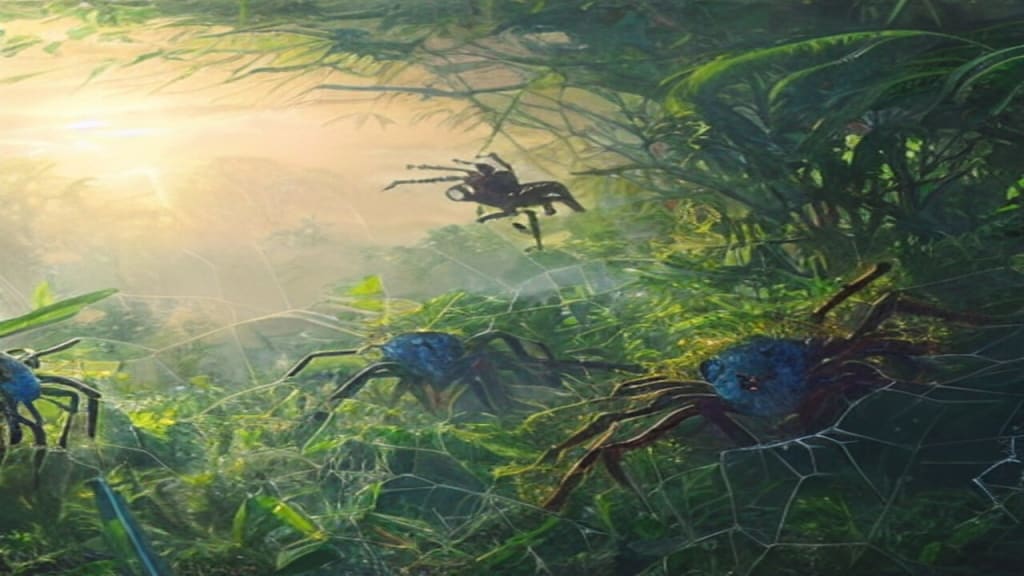The Mystery Of The Giant Spiders Of The Congo
Old Folktale Or Real?

They appear in legends and myth from ancient Greece to African folk or and even appear as a 150 foot geoglyph in the NASCAR deserts of Peru. Spiders come in a variety of colors and sizes ranging from the very tiny the Samoan moss spider measuring only zero 3 mm long to the massive the goliath bird eating spider which measures twelve inches long. However, if cryptozoologists are to be believed a much larger arachnid lurks in the rainforests of the Congo the Chiba FOFI. The Chiba FOFI live deep in the Congo and according to natives they build huge webs spanning from tree to tree using the leaves as a sort of camouflage often crossing game trails in other parts of the rainforest. The giant spiders apparently use a different web technique where they dig burrows under tree roots and cover the burrow with webs and trip lines which they camouflage with leaves similar to the technique used by the trapdoor spider. Adult jubafofi are said to look like giant tarantulas dark brown in color with a body measuring 28 to 30 inches in circumference roughly the size of a basketball with prominent fangs and very potent venom.
When standing fully upright they are as tall as a human. The eggs of the Chibafofi are a pale yellow color and are the size and shape of peanut shells. The young are bright yellow with a purple abdomen but become dark brown as they mature. The natives avoid these nests at all costs often taking a longer route to their destination. To avoid them. The native peoples of the Congo tell stories of the giant spiders coming into their villages killing livestock and taking away small animals and even children. What's more is that they build their huts with thatched roofs using a steep pitch to the ground and tightly spaced walls to prevent spiders from creeping inside. One of the oldest reported sightings of the Chibafofi was in 1890 from the English missionary Arthur Simes. He was en route to a village on the shore of Lake Nyassa in Uganda exploring as he traveled when several of his porters became ensnared in a huge sticky web that hung from one tree to another down to the ground. While in the process of cutting his porters from this web which was incredibly difficult to cut through two large spiders with a leg span of around 4ft appeared and attacked the men trapped in the web. Simes fired his pistol at the spiders and they hurried away. Simes rescued his porters from the web but the damage was already done. Within minutes of being rescued the men became feverish and the sight of their bites became swollen and died shortly afterwards. One of the most well known undocumented sightings came from Reginald Lloyd and his wife. In 1938 one of history's most terrifying giant spider sightings took place in the jungles of the Congo in central Africa. It happened to a British explorer, r. K. Lloyd, and his wife Marguerite. In 1938, Lloyd and his new bride decided to go on an adventure safari for their honeymoon. As Mr and Mrs Lloyd started to drive down this jungle track in the middle of the Congo rainforest, they saw a large but very odd looking creature crossing the trail ahead of them. Now, at first they thought this was either a very large monkey on all fours or maybe a large jungle cat. But as they got closer to this creature, they were horrified to see that it was actually a gigantic spider, something like a tarantula. According to Lloyd, the spider had a four to five foot legspan, but he was unable to document the sighting. As Lloyd reached for his camera, the giant spider started to scurry back into the forest and disappeared. The problem with the tales of such colossal spiders prowling through African jungles is not that sightings are few and far between, or that we only mostly rely on native accounts for information, nor even that we have no real physical evidence for them. No, the major problem with the Chibafofi, or indeed any reports of giant spiders from around the world, has always been one of physiology. There are two main hurdles for a spider to reach the sizes reported here. The first is respiration. Spiders have either book lungs, which are respiratory organs consisting of stacked alternating air pockets and tissue, or a tracheal respiratory system, consisting of a network of small tubes that branch out into the body, which is present in many insects as well. Many species of spiders have both. Yet the problem with these methods of respiration is that neither one of them is particularly efficient for exchanging atmospheric gas when dialed up to large sizes. This limits the sizes attainable by terrestrial insects and arachnids. Many of you reading may be thinking already of the numerous giant insects that once roamed the Earth many millions of years ago during the Carboniferous Period. But there was far more oxygen in the atmosphere in those days which could compensate for this inefficiency. Back in the old days of colonial Africa, explorers big game hunters from time to time, they encounter strange animals, including giant spiders. But they often don't report these observations for fear of just being ridiculed. After all, who's going to believe a story about a spider with a legspan of four or 5ft that's almost as big as a human being? Thankfully for the arachnophobes out there, the Chiba FOFI is quite possibly the unlikeliest of all the Congo cryptids. And trust me, that's saying something. Sure, the idea of living dinosaurs in the Congo is inherently far fetched, but at least they could exist from a biomechanical point of view. Unless the world returns the heavily oxygenated days of the Carboniferous period, we will not be seeing any massive arachnids outside of tall tales anytime soon.
About the Creator
Corey Turner
Reading really is fundamental






Comments
There are no comments for this story
Be the first to respond and start the conversation.